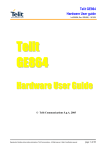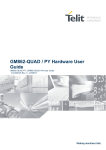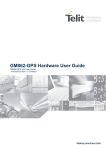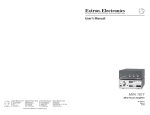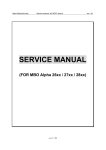Download GC864 Hardware User Guide
Transcript
GC864 Hardware User Guide 1vv0300733 Rev.1 - 07/09/06 GC864 Hardware User Guide 1vv0300733 Rev.1 - 07/09/06 This document is relating to the following products: Model GC864-QUAD GC864-PY P/N 3990250675 3990250676 Reproduction forbidden without Telit Communications S.p.A. written authorization - All Right reserved page 2 of 73 GC864 Hardware User Guide 1vv0300733 Rev.1 - 07/09/06 Contents 1 Overview........................................................................................................................................... 7 2 GC864 Mechanical Dimensions...................................................................................................... 8 3 GC864 module connections............................................................................................................. 9 3.1 3.1.1 4 GC864 Antenna connector.................................................................................................................................12 Hardware Commands ................................................................................................................... 13 4.1 Turning ON the GC864-QUAD / PY ..................................................................................................13 4.2 Turning OFF the GC864-QUAD / PY ................................................................................................15 4.2.1 4.2.2 5 PIN-OUT .................................................................................................................................................9 Hardware shutdown ...........................................................................................................................................15 Hardware Unconditional Restart........................................................................................................................15 Power Supply ................................................................................................................................. 17 5.1 Power Supply Requirements ...............................................................................................................17 5.2 General Design Rules ...........................................................................................................................18 5.2.1 Electrical Design Guidelines..............................................................................................................................18 5.2.1.1 + 5V input Source Power Supply Design Guidelines ...............................................................................18 5.2.1.2 + 12V Input Source Power Supply Design Guidelines .............................................................................19 5.2.1.3 Battery Source Power Supply Design Guidelines .....................................................................................20 5.2.1.4 Battery Charge control Circuitry Design Guidelines ................................................................................21 5.2.2 Thermal Design Guidelines ...............................................................................................................................22 5.2.3 Power Supply PCB layout Guidelines ...............................................................................................................23 6 7 8 Antenna........................................................................................................................................... 24 6.1 GSM Antenna Requirements ..............................................................................................................24 6.2 GSM Antenna - Installation Guidelines .............................................................................................25 Serial Port....................................................................................................................................... 26 7.1 RS232 level translation.........................................................................................................................28 7.2 5V UART level translation...................................................................................................................30 7.3 VAUX power output.............................................................................................................................31 Audio Section Overview ................................................................................................................ 32 8.1 Microphone Paths Characteristic and Requirements .......................................................................34 8.2 General Design Rules ...........................................................................................................................37 8.3 Other considerations ............................................................................................................................37 8.4 Microphone Biasing..............................................................................................................................38 8.4.1 8.4.2 Balanced Microphone Biasing...........................................................................................................................38 Unbalanced Microphone Biasing.......................................................................................................................39 Reproduction forbidden without Telit Communications S.p.A. written authorization - All Right reserved page 3 of 73 GC864 Hardware User Guide 1vv0300733 Rev.1 - 07/09/06 8.5 Microphone Buffering..........................................................................................................................41 8.5.1 8.5.2 9 Buffered Balanced Mic ......................................................................................................................................41 Buffered Unbalanced (Single Ended) Microphone ...........................................................................................43 OUTPUT LINES (Speaker) .......................................................................................................... 46 9.1 Short description ..................................................................................................................................46 9.2 Output Lines Characteristics ..............................................................................................................47 9.3 General Design Rules ...........................................................................................................................48 9.3.1 Noise Filtering ...................................................................................................................................................48 9.4 Handset Earphone Design....................................................................................................................49 9.5 Hands-Free Earphone (Low Power) Design.......................................................................................50 9.6 Car Kit Speakerphone Design .............................................................................................................51 10 SIM DESIGN GUIDES ................................................................................................................. 52 10.1 Data Integrity........................................................................................................................................52 10.2 EMI/EMC..............................................................................................................................................52 10.3 ESD ........................................................................................................................................................53 10.4 SIM Supply............................................................................................................................................53 10.5 SCHEMATIC .......................................................................................................................................53 10.6 LAYOUT ...............................................................................................................................................54 11 General Purpose I/O...................................................................................................................... 55 11.1 Logic level specifications ......................................................................................................................56 11.2 Using a GPIO Pad as INPUT...............................................................................................................57 11.3 Using a GPIO Pad as OUTPUT ..........................................................................................................57 11.4 Using the Alarm Output GPIO6 .........................................................................................................57 11.5 Using the Buzzer Output GPIO7 ........................................................................................................57 12 DAC and ADC section................................................................................................................... 59 12.1 DAC Converter .....................................................................................................................................59 12.1.1 12.1.2 12.1.3 12.2 Description ....................................................................................................................................................59 Enabling DAC ...............................................................................................................................................59 Low Pass Filter Example...............................................................................................................................60 ADC Converter .....................................................................................................................................61 12.2.1 12.2.2 Description ....................................................................................................................................................61 Using ADC Converter ...................................................................................................................................61 13 Camera ........................................................................................................................................... 62 13.1 Transchip Camera................................................................................................................................62 13.1.1 13.1.2 Camera Interface Connectors ........................................................................................................................63 EVB for Transchip camera support ...............................................................................................................65 Reproduction forbidden without Telit Communications S.p.A. written authorization - All Right reserved page 4 of 73 GC864 Hardware User Guide 13.1.3 13.1.4 13.1.5 1vv0300733 Rev.1 - 07/09/06 Block Diagram for supported cameras ..........................................................................................................66 Schematic Diagrams for supported camera ...................................................................................................67 Example usage script for camera...................................................................................................................68 13.2 Mounting the GC864 on your board...................................................................................................69 13.3 Packing system......................................................................................................................................70 14 Conformity Assessment Issues ..................................................................................................... 71 15 SAFETY RECOMMANDATIONS ............................................................................................. 72 16 Document Change Log .................................................................................................................. 73 Reproduction forbidden without Telit Communications S.p.A. written authorization - All Right reserved page 5 of 73 GC864 Hardware User Guide 1vv0300733 Rev.1 - 07/09/06 DISCLAIMER The information contained in this document is proprietary information of Telit Communications S.p.A. Telit Communications S.p.A. makes every effort to ensure the quality of the information it makes available. Notwithstanding the foregoing, Telit Communications S.p.A. does not make any warranty as to the information contained herein, and does not accept any liability for any injury, loss or damage of any kind incurred by use of or reliance upon the information. Telit Communications S.p.A. disclaims any and all responsibility for the application of the devices characterized in this document, and notes that the application of the device must comply with the safety standards of the applicable country, and where applicable, with the relevant wiring rules. Telit Communications S.p.A. reserves the right to make modifications, additions and deletions to this document at any time and without notice. © 2006 Telit Communications S.p.A. Reproduction forbidden without Telit Communications S.p.A. written authorization - All Right reserved page 6 of 73 GC864 Hardware User Guide 1vv0300733 Rev.1 - 07/09/06 1 Overview The aim of this document is the description of some hardware solutions useful for developing a product with the Telit GC864-QUAD / PY module. In this document all the basic functions of a mobile phone will be taken into account; for each one of them a proper hardware solution will be suggested and eventually the wrong solutions and common errors to be avoided will be evidenced. Obviously this document cannot embrace the whole hardware solutions and products that may be designed. The wrong solutions to be avoided shall be considered as mandatory, while the suggested hardware configurations shall not be considered mandatory, instead the information given shall be used as a guide and a starting point for properly developing your product with the Telit GC864-QUAD / PY module. For further hardware details that may not be explained in this document refer to the Telit GC864-QUAD / PY Product Description document where all the hardware information is reported. NOTICE GC864-QUAD GC864-QUAD GC864-QUAD GC864-QUAD GC864-QUAD GC864-QUAD GC864-QUAD The information presented in this document is believed to be accurate and reliable. However, no responsibility is assumed by Telit Communication S.p.A. for its use, nor any infringement of patents or other rights of third parties which may result from its use. No license is granted by implication or otherwise under any patent rights of Telit Communication S.p.A. other than for circuitry embodied in Telit products. This document is subject to change without notice. Reproduction forbidden without Telit Communications S.p.A. written authorization - All Right reserved page 7 of 73 GC864 Hardware User Guide 1vv0300733 Rev.1 - 07/09/06 2 GC864 Mechanical Dimensions The Telit GC864 module overall dimensions are: • • • Length: Width: Thickness: 36.2 mm 30 mm 3.2 mm Reproduction forbidden without Telit Communications S.p.A. written authorization - All Right reserved page 8 of 73 GC864 Hardware User Guide 1vv0300733 Rev.1 - 07/09/06 3 GC864 module connections 3.1 PIN-OUT The GC864 uses a 80 pin Molex p.n. 53949-0878 male connector for the connections with the external applications. This connector matches the 54150-0878 model. Pin Signal I/O Function Internal Pull up Type Power Supply 1 VBATT - Main power supply Power 2 VBATT - Main power supply Power 3 VBATT - Main power supply Power 4 VBATT - Main power supply Power 5 GND - Ground Power 6 GND - Ground Power 7 GND - Ground Power Audio 100KΩ 8 AXE I Handsfree switching 9 EAR_HF+ AO Handsfree ear output, phase + CMOS 2.8V Audio 10 EAR_HF- AO Handsfree ear output, phase - Audio 11 EAR_MT+ AO Handset earphone signal output, phase + Audio 12 EAR_MT- AO Handset earphone signal output, phase - Audio 13 MIC_HF+ AI Handsfree microphone input; phase +, nominal level 3mVrms Audio 14 MIC_HF- AI Handsfree microphone input; phase -, nominal level 3mVrms Audio 15 MIC_MT+ AI Handset microphone signal input; phase+, nominal level 50mVrms Audio 16 MIC_MT- AI Handset microphone signal input; phase-, nominal level 50mVrms Audio SIMVCC - External SIM signal – Power supply for the SIM 1.8/3V 19 SIMRST O External SIM signal – Reset 1.8/3V 20 SIMIO I/O External SIM signal - Data I/O 1.8/3V 21 SIMIN I External SIM signal - Presence (active low) 22 SIMCLK O External SIM signal – Clock SIM Card Interface 18 1 47KΩ 1.8/3V 1.8/3V Trace 1 On this line a maximum of 10nF bypass capacitor is allowed Reproduction forbidden without Telit Communications S.p.A. written authorization - All Right reserved page 9 of 73 GC864 Hardware User Guide 1vv0300733 Rev.1 - 07/09/06 Pin Signal I/O Function Internal Pull up Type 23 RX_TRACE I RX Data for debug monitor CMOS 2.8V 24 TX_TRACE O TX Data for debug monitor CMOS 2.8V Prog. / Data + Hw Flow Control 25 C103/TXD I Serial data input (TXD) from DTE CMOS 2.8V 26 C104/RXD O Serial data output to DTE CMOS 2.8V 27 C107/DSR O Output for Data set ready signal (DSR) to DTE CMOS 2.8V 28 C106/CTS O Output for Clear to send signal (CTS) to DTE CMOS 2.8V 29 C108/DTR I Input for Data terminal ready signal (DTR) from DTE CMOS 2.8V 30 C125/RING O Output for Ring indicator signal (RI) to DTE CMOS 2.8V 31 C105/RTS I Input for Request to send signal (RTS) from DTE CMOS 2.8V 32 C109/DCD O Output for Data carrier detect signal (DCD) to DTE CMOS 2.8V IIC 35 36 CAM_SCL / IIC_SCL CAM_SDA / IIC_SDA I/O Camera IIC interface / Configurable GPIO CMOS 2.8V I/O Camera IIC interface / Configurable GPIO CMOS 2.8V DAC and ADC 37 ADC_IN1 AI Analog/Digital converter input A/D 38 ADC_IN2 AI Analog/Digital converter input A/D 39 ADC_IN3 AI Analog/Digital converter input A/D 40 DAC_OUT AO Digital/Analog converter output D/A Miscellaneous Functions 44 MON1_CAM I/O MON1 / Camera interface CMOS 2.8V 45 STAT_LED O Status indicator led CMOS 1.8V 46 GND - Ground Ground 49 PWRMON O Power ON Monitor CMOS 2.8V 50 VAUX1 - Power output for external accessories - 51 CHARGE AI Charger input (*) Power 52 CHARGE AI Charger input (*) Power Pull up to VBATT 53 ON/OFF* I Input command for switching power ON or OFF (toggle command). The pulse to be sent to the GC864 must be equal or greater than 1 47KΩ second. 54 RESET* I Reset input 55 VRTC AO VRTC Backup capacitor Power Telit GPIO 56 TGPIO_19 I/O Telit GPIO19 Configurable GPIO CMOS 2.8V 57 TGPIO_11 I/O Telit GPIO11 Configurable GPIO CMOS 2.8V 58 TGPIO_20 I/O Telit GPIO20 Configurable GPIO CMOS 2.8V 59 TGPIO_04 I/O Telit GPIO4 Configurable GPIO CMOS 2.8V 60 TGPIO_14 I/O Telit GPIO14 Configurable GPIO CMOS 2.8V 61 TGPIO_15 I/O Telit GPIO15 GPIO pin CMOS 2.8V Reproduction forbidden without Telit Communications S.p.A. written authorization - All Right reserved page 10 of 73 GC864 Hardware User Guide 1vv0300733 Rev.1 - 07/09/06 Pin Signal I/O Function Internal Pull up Type 62 TGPIO_12 I/O Telit GPIO12 Configurable GPIO CMOS 2.8V 63 TGPIO_10 I/O Telit GPIO10 I/O pin CMOS 2.8V 64 TGPIO_22 I/O Telit GPIO22 Configurable GPIO CMOS 1.8V 65 TGPIO_18 I/O Telit GPIO18 I/O pin CMOS 2.8V 66 TGPIO_03 I/O Telit GPIO3 Configurable GPIO CMOS 2.8V 67 TGPIO_08 / CAM_ON I/O Telit GPIO8 Configurable GPIO / Camera Interface CMOS 2.8V 68 TGPIO_06 / ALARM I/O Telit GPIO6 Configurable GPIO / ALARM CMOS 2.8V CMOS 2.8V 69 TGPIO_23 I/O Reserved to detect ON/OFF. It is physically connected to pin 49 (PWRMON) 70 TGPIO_01 I/O Telit GPIO1 Configurable GPIO CMOS 2.8V 71 TGPIO_17 I/O Telit GPIO17 GPIO pin CMOS 2.8V 72 TGPIO_21 I/O Telit GPIO21 Configurable GPIO CMOS 2.8V 73 TGPIO_07 / BUZZER I/O Telit GPIO7 Configurable GPIO / Buzzer CMOS 2.8V 74 TGPIO_02 / JDR I/O Telit GPIO02 I/O pin / Jammer detect report CMOS 2.8V 75 TGPIO_16 I/O Telit GPIO16 Configurable GPIO CMOS 2.8V 76 TGPIO_09 CAM_RST I/O Telit GPIO9 GPIO I/O pin 7 Camera Interface CMOS 2.8V 77 TGPIO_13 I/O Telit GPIO13 Configurable GPIO CMOS 2.8V 78 TGPIO_05 RFTXMON I/O Telit GPIO05 Configurable GPIO / Transmitter ON monitor CMOS 2.8V / / RESERVED 17 - 33 - 34 - 41 - 42 - 43 - 47 - 48 - 79 - 80 - NOTE: RESERVED pins must not be connected 1 RTS should be connected to the GND ( on the module side) if flow control is not used Reproduction forbidden without Telit Communications S.p.A. written authorization - All Right reserved page 11 of 73 GC864 Hardware User Guide 1vv0300733 Rev.1 - 07/09/06 NOTE: If not used, almost all pins should be left disconnected. The only exceptions are the following pins: pin 1,2,3,4 5,6,7,46 25 26 31 53 54 signal GND VBATT TXD RXD RTS 2 ON/OFF* RESET* 3.1.1 GC864 Antenna connector The GC864 module is equipped with a 50 Ohm RF connector from Murata, GSC type P/N MM93292700B. The counterpart suitable is Murata MXTK92 Type or MXTK88 Type. Moreover, the GC864 has the antenna pads on the back side of the PCB. This allows the manual soldering of the coaxial cable directly on the back side of the PCB. However, the soldering is not an advisable solution for a reliable connection of the antenna. Reproduction forbidden without Telit Communications S.p.A. written authorization - All Right reserved page 12 of 73 GC864 Hardware User Guide 1vv0300733 Rev.1 - 07/09/06 4 Hardware Commands 4.1 Turning ON the GC864-QUAD / PY To turn on the GC864-QUAD / PY the pad ON# must be tied low for at least 1 seconds and then released. The maximum current that can be drained from the ON# pad is 0,1 mA. A simple circuit to do it is: ON# R1 Q1 Power ON impulse R2 GND NOTE: don't use any pull up resistor on the ON# line, it is internally pulled up. Using pull up resistor may bring to latch up problems on the GC864-QUAD / PY power regulator and improper power on/off of the module. The line ON# must be connected only in open collector configuration. NOTE: In this document all the lines that are inverted, hence have active low signals are labeled with a name that ends with a "#" or with a bar over the name. NOTE: The GC864-QUAD / PY turns fully on also by supplying power to the Charge pad (provided there's a battery on the VBATT pads). Reproduction forbidden without Telit Communications S.p.A. written authorization - All Right reserved page 13 of 73 GC864 Hardware User Guide 1vv0300733 Rev.1 - 07/09/06 For example: 1- Let's assume you need to drive the ON# pad with a totem pole output of a +3/5 V microcontroller (uP_OUT1): 1s 2- Let's assume you need to drive the ON# pad directly with an ON/OFF button: Reproduction forbidden without Telit Communications S.p.A. written authorization - All Right reserved page 14 of 73 GC864 Hardware User Guide 1vv0300733 Rev.1 - 07/09/06 4.2 Turning OFF the GC864-QUAD / PY The turning off of the device can be done in three ways: • by software command (see GC864-QUAD / PY Software User Guide) • by hardware shutdown • by Hardware Unconditional Restart When the device is shut down by software command or by hardware shutdown, it issues to the network a detach request that informs the network that the device will not be reachable any more. 4.2.1 Hardware shutdown To turn OFF the GC864-QUAD / PY the pad ON# must be tied low for at least 2 seconds and then released. The same circuitry and timing for the power on shall be used. The device shuts down after the release of the ON# pad. TIP: To check if the device has powered off, the hardware line PWRCTL should be monitored. When PWRCTL goes low, the device has powered off. 4.2.2 Hardware Unconditional Restart To unconditionally Restart the GC864-QUAD / PY, the pad RESET# must be tied low for at least 200 milliseconds and then released. The maximum current that can be drained from the ON# pad is 0,15 mA. A simple circuit to do it is: RESET# Unconditional Restart impulse GND Reproduction forbidden without Telit Communications S.p.A. written authorization - All Right reserved page 15 of 73 GC864 Hardware User Guide 1vv0300733 Rev.1 - 07/09/06 NOTE: don't use any pull up resistor on the RESET# line nor any totem pole digital output. Using pull up resistor may bring to latch up problems on the GC864-QUAD / PY power regulator and improper functioning of the module. The line RESET# must be connected only in open collector configuration. TIP: The unconditional hardware Restart should be always implemented on the boards and software should use it as an emergency exit procedure. For example: 1- Let's assume you need to drive the RESET# pad with a totem pole output of a +3/5 V microcontroller (uP_OUT2): Reset Signal Operating levels: Signal RESET Input high RESET Input low Min 2.2V* 0V Max 3.3V 0.2V * this signal is internally pulled up so the pin can be left floating if not used. Reproduction forbidden without Telit Communications S.p.A. written authorization - All Right reserved page 16 of 73 GC864 Hardware User Guide 1vv0300733 Rev.1 - 07/09/06 5 Power Supply The power supply circuitry and board layout are a very important part in the full product design and they strongly reflect on the product overall performances, hence read carefully the requirements and the guidelines that will follow for a proper design. 5.1 Power Supply Requirements The GC864-QUAD / PY power requirements are: • Nominal Supply Voltage: • Max Supply Voltage: • Supply voltage range: • Max Peak current consumption (impulsive): • Max Average current consumption during GPRS transmission (rms): • Max Average current consumption during VOICE/CSD transmission (rms): • Average current during Power Saving: • Average current during idle (Power Saving disabled) 3.8 V 4.2 V 3.4 V - 4.2 V 1.9 A 500 mA 270 mA ≈ 4 mA ≈ 19 mA The GSM system is made in a way that the RF transmission is not continuous, else it is packed into bursts at a base frequency of about 216 Hz, the relative current peaks can be as high as about 2A. Therefore the power supply has to be designed in order to withstand with these current peaks without big voltage drops; this means that both the electrical design and the board layout must be designed for this current flow. If the layout of the PCB is not well designed a strong noise floor is generated on the ground and the supply; this will reflect on all the audio paths producing an audible annoying noise at 216 Hz; if the voltage drop during the peak current absorption is too much, then the device may even shutdown as a consequence of the supply voltage drop. TIP: The electrical design for the Power supply should be made ensuring it will be capable of a peak current output of at least 2 A. Reproduction forbidden without Telit Communications S.p.A. written authorization - All Right reserved page 17 of 73 GC864 Hardware User Guide 1vv0300733 Rev.1 - 07/09/06 5.2 General Design Rules The principal guidelines for the Power Supply Design embrace three different design steps: - the electrical design - the thermal design. - the PCB layout. 5.2.1 Electrical Design Guidelines The electrical design of the power supply depends strongly from the power source where this power is drained. We will distinguish them into three categories: • +5V input (typically PC internal regulator output) • +12V input (typically automotive) • Battery 5.2.1.1 + 5V input Source Power Supply Design Guidelines • • • • • The desired output for the power supply is 3.8V, hence there's not a big difference between the input source and the desired output and a linear regulator can be used. A switching power supply will not be suited because of the low drop out requirements. When using a linear regulator, a proper heat sink shall be provided in order to dissipate the power generated. A Bypass low ESR capacitor of adequate capacity must be provided in order to cut the current absorption peaks close to the GC864-QUAD / PY, a 100μF tantalum capacitor is usually suited. Make sure the low ESR capacitor on the power supply output (usually a tantalum one) is rated at least 10V. A protection diode should be inserted close to the power input, in order to save the GC864-QUAD / PY from power polarity inversion. Reproduction forbidden without Telit Communications S.p.A. written authorization - All Right reserved page 18 of 73 GC864 Hardware User Guide 1vv0300733 Rev.1 - 07/09/06 An example of linear regulator with 5V input is: 5.2.1.2 + 12V Input Source Power Supply Design Guidelines • • • • • • • The desired output for the power supply is 3.8V, hence due to the big difference between the input source and the desired output, a linear regulator is not suited and shall not be used. A switching power supply will be preferable because of its better efficiency especially with the 2A peak current load represented by the GC864-QUAD / PY. When using a switching regulator, a 500kHz or more switching frequency regulator is preferable because of its smaller inductor size and its faster transient response. This allows the regulator to respond quickly to the current peaks absorption. For car PB battery the input voltage can rise up to 15,8V and this should be kept in mind when choosing components: all components in the power supply must withstand this voltage. A Bypass low ESR capacitor of adequate capacity must be provided in order to cut the current absorption peaks, a 100μF tantalum capacitor is usually suited. Make sure the low ESR capacitor on the power supply output (usually a tantalum one) is rated at least 10V. For Car applications a spike protection diode should be inserted close to the power input, in order to clean the supply from spikes. A protection diode should be inserted close to the power input, in order to save the GC864-QUAD / PY from power polarity inversion. This can be the same diode as for spike protection. Reproduction forbidden without Telit Communications S.p.A. written authorization - All Right reserved page 19 of 73 GC864 Hardware User Guide 1vv0300733 Rev.1 - 07/09/06 An example of switching regulator with 12V input is: 5.2.1.3 Battery Source Power Supply Design Guidelines • The desired nominal output for the power supply is 3.8V and the maximum voltage allowed is 4.2V, hence a single 3.7V Li-Ion cell battery type is suited for supplying the power to the Telit GC864-QUAD / PY module. The three cells Ni/Cd or Ni/MH 3,6 V Nom. battery types or 4V PB types MUST NOT BE USED DIRECTLY since their maximum voltage can rise over the absolute maximum voltage for the GC864-QUAD / PY and damage it. NOTE: DON'T USE any Ni-Cd, Ni-MH, and Pb battery types directly connected with GC864-QUAD / PY. Their use can lead to overvoltage on the GC864-QUAD / PY and damage it. USE ONLY Li-Ion battery types. • • • • A Bypass low ESR capacitor of adequate capacity must be provided in order to cut the current absorption peaks, a 100μF tantalum capacitor is usually suited. Make sure the low ESR capacitor (usually a tantalum one) is rated at least 10V. A protection diode should be inserted close to the power input, in order to save the GC864-QUAD / PY from power polarity inversion. Otherwise the battery connector should be done in a way to avoid polarity inversions when connecting the battery. The battery capacity must be at least 500mAh in order to withstand the current peaks of 2A; the suggested capacity is from 500mAh to 1000mAh. Reproduction forbidden without Telit Communications S.p.A. written authorization - All Right reserved page 20 of 73 GC864 Hardware User Guide 1vv0300733 Rev.1 - 07/09/06 5.2.1.4 Battery Charge control Circuitry Design Guidelines The charging process for Li-Ion Batteries can be divided into 4 phases: • Qualification and trickle charging • Fast charge 1 - constant current • Final charge - constant voltage or pulsed charging • Maintenance charge The qualification process consists in a battery voltage measure, indicating roughly its charge status. If the battery is deeply discharged, that means its voltage is lower than the trickle charging threshold, then the charge must start slowly possibly with a current limited pre-charging process where the current is kept very low with respect to the fast charge value: the trickle charging. During the trickle charging the voltage across the battery terminals rises; when it reaches the fast charge threshold level the charging process goes into fast charge phase. During the fast charge phase the process proceeds with a current limited charging; this current limit depends on the required time for the complete charge and from the battery pack capacity. During this phase the voltage across the battery terminals still raises but at a lower rate. Once the battery voltage reaches its maximum voltage then the process goes into its third state: Final charging. The voltage measure to change the process status into final charge is very important. It must be ensured that the maximum battery voltage is never exceeded, otherwise the battery may be damaged and even explode. Moreover for the constant voltage final chargers, the constant voltage phase (final charge) must not start before the battery voltage has reached its maximum value, otherwise the battery capacity will be highly reduced. The final charge can be of two different types: constant voltage or pulsed. GC864-QUAD / PY uses constant voltage. The constant voltage charge proceeds with a fixed voltage regulator (very accurately set to the maximum battery voltage) and hence the current will decrease while the battery is becoming charged. When the charging current falls below a certain fraction of the fast charge current value, then the battery is considered fully charged, the final charge stops and eventually starts the maintenance. The pulsed charge process has no voltage regulation, instead the charge continues with pulses. Usually the pulse charge works in the following manner: the charge is stopped for some time, let's say few hundreds of ms, then the battery voltage will be measured and when it drops below its maximum value a fixed time length charging pulse is issued. As the battery approaches its full charge the off time will become longer, hence the duty-cycle of the pulses will decrease. The battery is considered fully charged when the pulse duty-cycle is less than a threshold value, typically 10%, the pulse charge stops and eventually the maintenance starts. The last phase is not properly a charging phase, since the battery at this point is fully charged and the process may stop after the final charge. The maintenance charge provides an additional charging process to compensate for the charge leak typical of a Li-Ion battery. It is done by issuing pulses with a fixed time length, again few hundreds of ms, and a duty-cycle around 5% or less. This last phase is not implemented in the GC864-QUAD / PY internal charging algorithm, so that the battery once charged is left discharging down to a certain threshold so that it is cycled from full charge to slight discharge even if the battery charger is always inserted. This guarantees that anyway the remaining charge in the battery is a good percentage and that the battery is not damaged by keeping it always fully charged (Li-Ion rechargeable battery usually deteriorate when kept fully charged). Reproduction forbidden without Telit Communications S.p.A. written authorization - All Right reserved page 21 of 73 GC864 Hardware User Guide 1vv0300733 Rev.1 - 07/09/06 Last but not least, in some applications it is highly desired that the charging process restarts when the battery is discharged and its voltage drops below a certain threshold, GC864-QUAD / PY internal charger does it. As you can see, the charging process is not a trivial task to be done; moreover all these operations should start only if battery temperature is inside a charging range, usually 5°C - 45°C. The GC864-QUAD / PY measures the temperature of its internal component, in order to satisfy this last requirement, it's not exactly the same as the battery temperature but in common application the two temperature should not differ too much and the charging temperature range should be guaranteed. NOTE: For all the threshold voltages, inside the GC864-QUAD / PY all threshold are fixed in order to maximize Li-Ion battery performances and do not need to be changed. NOTE: In this application the battery charger input current must be limited to less than 400mA. This can be done by using a current limited wall adapter as the power source. 5.2.2 Thermal Design Guidelines The thermal design for the power supply heat sink should be done with the following specifications: • Average current consumption during transmission @PWR level max (rms): 500mA • Average current consumption during transmission @ PWR level min (rms): 100mA • Average current during Power Saving: 4mA • Average current during idle (Power Saving disabled) 19mA NOTE: The average consumption during transmissions depends on the power level at which the device is requested to transmit by the network. The average current consumption hence varies significantly. Considering the very low current during idle, especially if Power Saving function is enabled, it is possible to consider from the thermal point of view that the device absorbs current significantly only during calls. If we assume that the device stays into transmission for short periods of time (let's say few minutes) and then remains for a quite long time in idle (let's say one hour), then the power supply has always the time to cool down between the calls and the heat sink could be smaller than the calculated one for 500mA maximum RMS current, or even could be the simple chip package (no heat sink). Moreover in the average network conditions the device is requested to transmit at a lower power level than the maximum and hence the current consumption will be less than the 500mA, being usually around 150mA. For these reasons the thermal design is rarely a concern and the simple ground plane where the power supply chip is placed can be enough to ensure a good thermal condition and avoid overheating. For the heat generated by the GC864-QUAD / PY, you can consider it to be during transmission 1W max during CSD/VOICE calls and 2W max during class10 GPRS upload. Reproduction forbidden without Telit Communications S.p.A. written authorization - All Right reserved page 22 of 73 GC864 Hardware User Guide 1vv0300733 Rev.1 - 07/09/06 This generated heat will be mostly conducted to the ground plane under the GC864-QUAD / PY; you must ensure that your application can dissipate it. 5.2.3 Power Supply PCB layout Guidelines As seen on the electrical design guidelines the power supply shall have a low ESR capacitor on the output to cut the current peaks and a protection diode on the input to protect the supply from spikes and polarity inversion. The placement of these components is crucial for the correct working of the circuitry. A misplaced component can be useless or can even decrease the power supply performances. • • • • • • • • The Bypass low ESR capacitor must be placed close to the Telit GC864-QUAD / PY power input pads or in the case the power supply is a switching type it can be placed close to the inductor to cut the ripple provided the PCB trace from the capacitor to the GC864-QUAD / PY is wide enough to ensure a dropless connection even during the 2A current peaks. The protection diode must be placed close to the input connector where the power source is drained. The PCB traces from the input connector to the power regulator IC must be wide enough to ensure no voltage drops occur when the 2A current peaks are absorbed. Note that this is not made in order to save power loss but especially to avoid the voltage drops on the power line at the current peaks frequency of 216 Hz that will reflect on all the components connected to that supply, introducing the noise floor at the burst base frequency. For this reason while a voltage drop of 300400 mV may be acceptable from the power loss point of view, the same voltage drop may not be acceptable from the noise point of view. If your application doesn't have audio interface but only uses the data feature of the Telit GC864-QUAD / PY, then this noise is not so disturbing and power supply layout design can be more forgiving. The PCB traces to the GC864-QUAD / PY and the Bypass capacitor must be wide enough to ensure no significant voltage drops occur when the 2A current peaks are absorbed. This is for the same reason as previous point. Try to keep this trace as short as possible. The PCB traces connecting the Switching output to the inductor and the switching diode must be kept as short as possible by placing the inductor and the diode very close to the power switching IC (only for switching power supply). This is done in order to reduce the radiated field (noise) at the switching frequency (100-500 kHz usually). The use of a good common ground plane is suggested. The placement of the power supply on the board should be done in such a way to guarantee that the high current return paths in the ground plane are not overlapped to any noise sensitive circuitry as the microphone amplifier/buffer or earphone amplifier. The power supply input cables should be kept separate from noise sensitive lines such as microphone/earphone cables. Reproduction forbidden without Telit Communications S.p.A. written authorization - All Right reserved page 23 of 73 GC864 Hardware User Guide 1vv0300733 Rev.1 - 07/09/06 6 Antenna The antenna connection and board layout design are the most important part in the full product design and they strongly reflect on the product overall performances, hence read carefully and follow the requirements and the guidelines for a proper design. 6.1 GSM Antenna Requirements As suggested on the Product Description the antenna for a Telit GC864-QUAD / PY device shall fulfill the following requirements: ANTENNA REQUIREMENTS Frequency range Bandwidth Gain Impedance Input power VSWR absolute max VSWR recommended Standard Dual Band GSM/DCS frequency range or Standard Quad Band GSM/DCS/PCS frequency range if used for all four bands 80 MHz in GSM & 170 MHz in DCS & 140 MHz PCS band Gain < 3dBi 50 ohm > 2 W peak power <= 10:1 <= 2:1 Furthermore if the device is developed for the US market and/or Canada market, it shall comply to the FCC and/or IC approval requirements: This device is to be used only for mobile and fixed application. The antenna(s) used for this transmitter must be installed to provide a separation distance of at least 20 cm from all persons and must not be co-located or operating in conjunction with any other antenna or transmitter. End-Users must be provided with transmitter operation conditions for satisfying RF exposure compliance. OEM integrators must ensure that the end user has no manual instructions to remove or install the GC864-QUAD / PY module. Antennas used for this OEM module must not exceed 3dBi gain for mobile and fixed operating configurations. Reproduction forbidden without Telit Communications S.p.A. written authorization - All Right reserved page 24 of 73 GC864 Hardware User Guide 1vv0300733 Rev.1 - 07/09/06 6.2 GSM Antenna - Installation Guidelines • • • • Install the antenna in a place covered by the GSM signal. The Antenna must be installed to provide a separation distance of at least 20 cm from all persons and must not be co-located or operating in conjunction with any other antenna or transmitter; Antenna shall not be installed inside metal cases Antenna shall be installed also according Antenna manufacturer instructions. Reproduction forbidden without Telit Communications S.p.A. written authorization - All Right reserved page 25 of 73 GC864 Hardware User Guide 1vv0300733 Rev.1 - 07/09/06 7 Serial Port The serial port on the Telit GC864 is the core of the interface between the module and OEM hardware. Several configurations can be designed for the serial port on the OEM hardware, but the most common are: - RS232 PC com port - microcontroller UART @ 2.8V - 3V (Universal Asynchronous Receive Transmit) - microcontroller UART@ 5V or other voltages different from 2.8V Depending from the type of serial port on the OEM hardware a level translator circuit may be needed to make the system work. The only configuration that doesn't need a level translation is the 2.8V UART. The serial port on the GC864 is a +2.8V UART with all the 7 RS232 signals. It differs from the PCRS232 in the signal polarity (RS232 is reversed) and levels. The levels for the GC864 UART are the CMOS levels: Absolute Maximum Ratings -Not Functional Parameter Min Max Input level on any -0.3V digital pad when on Input voltage on -0.3V analog pads when on +3.75V +3.0 V Operating Range - Interface levels (2.8V CMOS) Level Min Max Input high level VIH 2.1V Input low level VIL 0V Output high level VOH 2.2V Output low level VOL 0V 3.3V 0.5V 3.0V 0.35V Reproduction forbidden without Telit Communications S.p.A. written authorization - All Right reserved page 26 of 73 GC864 Hardware User Guide 1vv0300733 Rev.1 - 07/09/06 The signals of the GC864 serial port are: RS232 Pin Nr 1 2 3 4 5 6 7 8 9 Signal DCD dcd_uart RXD tx_uart TXD rx_uart DTR dtr_uart GND DSR dsr_uart RTS rts_uart CTS cts_uart RI ri_uart GC864 pin Number 32 Name Usage Data Carrier Detect 26 Transmit line *see Note Output from the GC864 that indicates the carrier presence Output transmit line of GC864 UART 25 Receive line *see Note Input receive of the GC864 UART 29 Data Terminal Ready 5,6,7 27 Ground Data Set Ready 31 Request to Send 28 Clear to Send 30 Ring Indicator Input to the GC864 that controls the DTE READY condition ground Output from the GC864 that indicates the module is ready Input to the GC864 that controls the Hardware flow control Output from the GC864 that controls the Hardware flow control Output from the GC864 that indicates the incoming call condition NOTE: According to V.24, RX/TX signal names are referred to the application side, therefore on the GC864 side these signal are on the opposite direction: TXD on the application side will be connected to the receive line (here named TXD/ rx_uart ) of the GC864 serial port and viceversa for RX. TIP: For a minimum implementation, only the TXD and RXD lines can be connected, the other lines can be left open provided a software flow control is implemented. The signals in the UART connector on the EVK2 are: DCD TXD GND RTS RI RXD DTR DSR CTS GND Reproduction forbidden without Telit Communications S.p.A. written authorization - All Right reserved page 27 of 73 GC864 Hardware User Guide 1vv0300733 Rev.1 - 07/09/06 7.1 RS232 level translation In order to interface the Telit GC864 with a PC com port or a RS232 (EIA/TIA-232) application a level translator is required. This level translator must - invert the electrical signal in both directions - change the level from 0/3V to +15/-15V Actually, the RS232 UART 16450, 16550, 16650 & 16750 chipsets accept signals with lower levels on the RS232 side (EIA/TIA-562) , allowing for a lower voltage-multiplying ratio on the level translator. Note that the negative signal voltage must be less than 0V and hence some sort of level translation is always required. The simplest way to translate the levels and invert the signal is by using a single chip level translator. There are a multitude of them, differing in the number of driver and receiver and in the levels (be sure to get a true RS232 level translator not a RS485 or other standards). By convention the driver is the level translator from the 0-3V UART level to the RS232 level, while the receiver is the translator from RS232 level to 0-3V UART. In order to translate the whole set of control lines of the UART you will need: - 5 driver - 3 receiver NOTE: The digital input lines working at 2.8VCMOS have an absolute maximum input voltage of 3,75V; therefore the level translator IC shall not be powered by the +3.8V supply of the module. Instead it shall be powered from a +2.8V / +3.0V (dedicated) power supply. This is because in this way the level translator IC outputs on the module side (i.e. GC864 inputs) will work at +3.8V interface levels, stressing the module inputs at its maximum input voltage. This can be acceptable for evaluation purposes, but not on production devices. NOTE: In order to be able to do in circuit reprogramming of the GC864 firmware, the serial port on the Telit GC864 shall be available for translation into RS232 and either it's controlling device shall be placed into tristate, disconnected or as a gateway for the serial data when module reprogramming occurs. Only RXD, TXD, GND and the On/off module turn on pad are required to the reprogramming of the module, the other lines are unused. All applicator shall include in their design such a way of reprogramming the GC864. Reproduction forbidden without Telit Communications S.p.A. written authorization - All Right reserved page 28 of 73 GC864 Hardware User Guide 1vv0300733 Rev.1 - 07/09/06 An example of level translation circuitry of this kind is: the RS232 serial port lines are usually connected to a DB9 connector with the following layout: Reproduction forbidden without Telit Communications S.p.A. written authorization - All Right reserved page 29 of 73 GC864 Hardware User Guide 1vv0300733 Rev.1 - 07/09/06 7.2 5V UART level translation If the OEM application uses a microcontroller with a serial port (UART) that works at a voltage different from 2.8 - 3V, then a circuitry has to be provided to adapt the different levels of the two sets of signals. As for the RS232 translation there are a multitude of single chip translators, but since the translation requires very few components, then also a discrete design can be suited. For example a possible inexpensive translator circuit for a 5V driver can be: and for a 5V receiver: Reproduction forbidden without Telit Communications S.p.A. written authorization - All Right reserved page 30 of 73 GC864 Hardware User Guide 1vv0300733 Rev.1 - 07/09/06 NOTE: The UART input line TXD (rx_uart) of the GC864 is NOT internally pulled up with a resistor, so there may be the need to place an external 47KΩ pull-up resistor, either the DTR (dtr_uart) and RTS (rts_uart) input lines are not pulled up internally, so an external pull-up resistor of 47KΩ may be required. 7.3 VAUX power output A regulated power supply output is provided in order to supply small devices from module. This output is active when the module is ON and goes off when module is shut down. The operating range characteristics of the supply are: Operating Range - Vout power supply Min Typ Max Output voltage 2.95V Output current Output bypass capacitor 2.75V 2.85V 100mA 2.2μF Pull-up resistors can be connected to the VAUX pad provided that the pulled-up lines are GC864 input lines connected to open collector outputs in order to avoid latch-up problems on the GC864. Care must be taken to avoid latch-up on the GC864 and the use of this output line to power electronic devices shall be considered with care, especially for devices that generate spikes and noise such as level translators, digital ICs or microcontroller, failure in any of these condition can severely compromise the GC864 functionality. NOTE: The input lines working at 2.8VCMOS can be pulled-up with 47KΩ resistors that can be connected directly to the VAUX line. NO disturbing devices should be powered with the VAUX line, otherwise the module functionality may be compromised. Reproduction forbidden without Telit Communications S.p.A. written authorization - All Right reserved page 31 of 73 GC864 Hardware User Guide 1vv0300733 Rev.1 - 07/09/06 8 Audio Section Overview The Base Band Chip of the GC864-QUAD / PY Telit Module provides two different audio blocks; both in transmit (Uplink) and in receive (Downlink) direction: “MT lines” should be used for handset function, “HF lines” is suited for hands -free function (car kit). These two blocks can be active only one at a time, selectable by AXE hardware line or by AT command. The audio characteristics are equivalent in transmit blocks, but are different in the receive ones and this should be kept in mind when designing. Reproduction forbidden without Telit Communications S.p.A. written authorization - All Right reserved page 32 of 73 50cm 7cm 3,3mV rms -45dBV/Pa -45dBV/Pa 0,33mV rms 23mVrms 365mV rms GE863-GPS Audio Paths +10dB +20dB Ear_HF- Ear_HF+ Mic_HF+ Mic_HF- Ear_MT- Mic_MT- Ear_MT+ GM863-GPS Mic_MT+ Single ended Balanced Fully Differential Power Buffers Differential Line-Out Drivers 16 -12dBFS 16 audio2.skd 8 GC864 Hardware User Guide 1vv0300733 Rev.1 - 07/09/06 EXTERNAL AMPLIFIER Reproduction forbidden without Telit Communications S.p.A. written authorization - All Right reserved page 33 of 73 GC864 Hardware User Guide 1vv0300733 Rev.1 - 07/09/06 8.1 Microphone Paths Characteristic and Requirements TIP: being the microphone circuitry the more noise sensitive , its design and layout must be done with particular care. Both microphone paths are balanced and the OEM circuitry should be balanced designed to reduce the common mode noise typically generated on the ground plane. However also an unbalanced circuitry can be used for particular OEM application needs . TIP: due to the difference in the echo canceller type, the “Mic_MT” audio path is suited for Handset applications, while the “Mic_HF”audio path is suited for hands-free function (car kit). The Earphone applications should be made using the “Mic_HF” audio path but DISABLING the echo canceller by software AT command. If the echo canceller is left active with the Earphone, then some echo might be introduced by the echo cancel algorithm. “Mic_MT” 1st differential microphone path • • • • • • • • line coupling line type coupling capacitor differential input resistance differential input voltage microphone nominal sensitivity analog gain suggested echo canceller type AC balanced ≥ 100nF 50kΩ ≤ 1,03Vpp (365mVrms) -45 dBVrms/Pa + 20dB handset “Mic_HF” 2nd differential microphone path • • • • • • line coupling line type coupling capacitor differential input resistance differential input voltage microphone nominal sensitivity AC balanced ≥ 100nF 50kΩ ≤ 65mVpp (23mVrms) -45 dBVrms/Pa • • analog gain suggested echo canceller type +10dB car kit hands-free Reproduction forbidden without Telit Communications S.p.A. written authorization - All Right reserved page 34 of 73 GC864 Hardware User Guide 1vv0300733 Rev.1 - 07/09/06 TIP: definition of the nominal sensitivity of the microphone lines . The nominal sensitivity of the microphone lines indicates the voltage level on the GC864-QUAD / PY pins present during "normal spoken" conditions. For a handset , the "normal spoken” conditions take place when the talker mouth is 7cm far from the microphone ; under these conditions the voice will produce an acoustic pressure of -4,7dBPa @1kHz on the microphone membrane . TIP: electrical equivalent signal and operating voice levels . At "normal spoken" conditions, a microphone having the suggested nominal sensitivity of 45dBVrms/Pa , will produce the electrical equivalent signal : that means : MicLevel = ( -45) + (-4.7) = -49.7 dBVrms MicVoltage = 10 ( -49.7 / 20 ) = 3.3* 10 -3 Vrms During a call, this level varies according to the volume of the talker voice; usually the following rough thumb rule for the dynamic range may be used : 1) the talker is screaming . This is the strongest voice level condition: the signal increases by +20dB; 2) the talker is whispering. This is the lowest voice level condition: the voice level decreases by – 50dB. These changes must be considered for designing the external microphone amplifier. TIP: example of external microphone amplifier calculation . Let’s suppose to use the 1stdifferential microphone path .In this case the maximum differential input voltage to “Mic_MT” lines is 365mVrms(1,03Vpp) corresponding to –8,76dBV. Now we can calculate the maximum voltage gain of an external microphone amplifier GA : [(MicLevel + 20dB ) + G A ] = −8,76dBV [− 49,7 + 20 + G A ] = −8,76 − 40,9 + 20 = −G A G A = 20,94dB you can set GA= +20dB to use standard resistor values . Reproduction forbidden without Telit Communications S.p.A. written authorization - All Right reserved page 35 of 73 GC864 Hardware User Guide 1vv0300733 Rev.1 - 07/09/06 TIP: environment consideration . For hands-free/car kit microphone, you must take into account the voice attenuation, due to the distance between the microphone itself and the talker , when designing the external microphone amplifier. Not only, you must consider that the microphone will pick up also ambient noise; to overcome this problem it is preferable to set the gain of the microphone 10dB lower with respect to the calculated value for a nominal sensitivity. The corresponding reduction in signal level will be compensated by an increased voice volume of the talker which will speak louder because of the ambient noise. For a car cabin usually the distance between the microphone itself and the talker is 40/50cm ; in these conditions the attenuation can be considered as a thumb rule around 20dB . For the earphone we shall distinguish two different types: the earphones having the microphone sustained close to the mouth and the ones having the microphone on the earpiece cable. The same considerations for the additional voice attenuation due to the distance from the microphone and the noise pick up can be made for the earphone having the microphone on the earpiece cable, while the other kind of earphone shall be threaten as an handset. TIP: how to compensate the losses in car cabin hands-free condition . The voice signal , that in the "normal spoken” conditions produces on the microphone membrane an acoustic pressure of -4,7dBPa at 1kHz , will have a further attenuation of 20dB due the 50cm distance . Therefore a microphone having the suggested nominal sensitivity of -45dBVrms/Pa,will produce a lower electrical equivalent signal : MicLevel = ( -45) + (-4.7)-20 = -69.7 that means : MicVoltage = 10 ( -49.7 / 20 ) = 0,33* 10 -3 Setting the “microphone gain” at +10dB (3 times), the signal in the nominal conditions on the “Mic_HF” inputs s of GC864-QUAD / PY Telit Module will be : “Mic_HF” Level = 0,33* 10 -3 * 3=1* 10 -3 Hence in these conditions the signal level on the“Mic_HF” input pads of the GC864-QUAD / PY is 10 dB (3 times) lower than the nominal, as suggested. Reproduction forbidden without Telit Communications S.p.A. written authorization - All Right reserved page 36 of 73 GC864 Hardware User Guide 1vv0300733 Rev.1 - 07/09/06 8.2 General Design Rules There are several configurations for the audio paths, but the most effective difference is between balanced and unbalanced microphone configuration. It is highly recommended to keep the whole microphone path balanced even if this means having 2 wires connecting the microphone instead of one needed (plus ground) in the unbalanced case. The balanced circuitry is more suited because of its good common mode noise rejection, reducing the 216 Hz burst noise produced during the GSM transmissions. • Where possible use balanced microphone circuitry • Keep the microphone traces on the PCB and wires as short as possible. • If your application requires an unbalanced microphone, then keep the lines on the PCB balanced and "unbalance" the path close to the microphone wire connector if possible. • For the microphone biasing voltage use a dedicated voltage regulator and a capacitor multiply circuit. • Make sure that the microphone traces in the PCB don't cross or run parallel to noisy traces (especially the power line) • If possible put all around to the microphone lines a ground trace connected to the ground plane by several vias. This is done in order to simulate a shielded trace on the PCB. • The biasing circuit and eventually the buffer can be designed in the same manner for the internal and external microphones. 8.3 Other considerations If your application is a hands-free/car kit scenario , but you need to put microphone and speaker inside the same box : • try to have the maximum possible distance between them, at least 7cm ; • becauses the microphone type is very important, if you use an omni-directional one ( and this is the typical applicaton ) please seal it on the rear side (no back cavity) in order not to collect unwanted signals ; • try to make divergent the main axes of the two devices . Reproduction forbidden without Telit Communications S.p.A. written authorization - All Right reserved page 37 of 73 GC864 Hardware User Guide 1vv0300733 Rev.1 - 07/09/06 8.4 Microphone Biasing The electret microphones usually need a biasing voltage to work properly. Refer to your microphone provider for the characteristics required. NOTE: The microphones have a hot wire were the positive biasing must be connected. Usually it is indicated by a + symbol or a red point. If the polarity of the bias is reversed, then the microphone will not work properly. For this reason be sure to respect the mic. biasing polarity. 8.4.1 Balanced Microphone Biasing The balanced microphone bias voltage should be obtained from a dedicated voltage regulator, in order to eliminate the noise present on the power lines. This regulator can be the same for all the audio paths. The microphone should be supplied from a capacitor multiply circuit. For example a circuit for the balanced microphone biasing can be: Reproduction forbidden without Telit Communications S.p.A. written authorization - All Right reserved page 38 of 73 GC864 Hardware User Guide 1vv0300733 Rev.1 - 07/09/06 NOTE: In the balanced application the resistors R2 and R3 must have the same value to keep the circuit balanced. NOTE: The cable to the microphone should not be shielded, instead a twisted pair cable shall be used. NOTE: The microphone sensitivity changes with the value of R2 and R3. Usually the microphones are characterized with 2kΩ biasing resistance, so try to keep the sum of R2 and R3 around 2kΩ. Refer to your microphone manufacturer for the mic. characteristics. 8.4.2 Unbalanced Microphone Biasing The unbalanced microphone biasing voltage should be obtained from a dedicated voltage regulator, in order to eliminate the noise present on the power lines. This regulator can be the same for all the audio paths. The microphone should be supplied from a capacitor multiply circuit. For example a circuit for the unbalanced microphone biasing can be: Reproduction forbidden without Telit Communications S.p.A. written authorization - All Right reserved page 39 of 73 GC864 Hardware User Guide 1vv0300733 Rev.1 - 07/09/06 NOTE: In the unbalanced application the capacitor C3 shall be > 200nF otherwise the frequency response will be cut at low band frequencies (down to 300Hz). This capacitor can be placed close to the MIC- pad (MIC_HF- or MIC_MT- depending on the audio path chosen) or if possible it should be placed close to the shielded cable connector. If the ground return path is well designed, then it is possible to eliminate the C3 capacitor, provided the buffer is close to the mic. input. NOTE: The cable to the microphone should be shielded. NOTE: The microphone changes with the value of R2. Usually the microphone sensitivity is characterized with 2kΩ biasing resistance, so try to keep the value of R2 around 2kΩ. For mic. characteristics refer to the manufacturer. Reproduction forbidden without Telit Communications S.p.A. written authorization - All Right reserved page 40 of 73 GC864 Hardware User Guide 1vv0300733 Rev.1 - 07/09/06 8.5 Microphone Buffering As seen previously, a microphone shall be connected to the input pins of the GC864-QUAD / PY through a buffer amplifier that boosts the signal level to the required value. Again the buffered microphone circuitry can be balanced or unbalanced: where possible it is always preferable a balanced solution. The buffering circuit shall be placed close to the microphone or close to the microphone wire connector. 8.5.1 Buffered Balanced Mic A sample circuit can be: +20dB 15K to GE863 270pF 15K 270pF This circuit has a gain of 10 times (+20 dB), and is therefore suited for the “Mic_MT “ input if you have a microphone with a sensitivity close to the suggested one (-45 dBVrms/Pa). If your microphone has a different sensitivity or if the buffer is connected to the “Mic_HF “ inputs , then a gain adjustment shall be done by changing resistors R604 and R606 ( if the required value is not a standard one , you can change R605 e R607 ) and as a consequence the capacitors C636 and C637 to maintain the bandwidth 150-4000Hz (at -3dB). Reproduction forbidden without Telit Communications S.p.A. written authorization - All Right reserved page 41 of 73 GC864 Hardware User Guide 1vv0300733 Rev.1 - 07/09/06 The buffer gain is given by the formula: Gain = R604 R606 = R605 R607 The C636 and C637 capacitors are placed in order to cut off the gain at higher frequencies than the transmitted GSM band, the cutoff frequency (-3dB) should be 3500Hz in order to have -1dB at 3kHz. The cutoff frequency is given by the formula: freq. = 1 1 = [Hz] 2π * R604 * C 637 2π * R606 * C 636 TIP: example of calculation . Let's assume you have a microphone with a sensitivity of -45 dBVrms/Pa and you want to use it in 1st differential microphone path (“Mic_MT” inputs) in "normal spoken" conditions at acoustic pressure of -4.7dBPa. As reported at page 33 , the electrical level output from the microphone will be : MicLevel = ( -45) + (-4.7) = -49.7 dBVrms corresponding to: MicVoltage = 10 ( -49.7 / 20 ) = 3.3* 10 -3 Vrms When the talker is screaming ,we will have a signal of 330 mVrms on the “Mic_MT “ inputs due to a 20dB higher Mic Level (see TIP 1) with a buffer gain GA : GA =20 log (AmplifierOutput / MicVoltage) =20 log (330 * 10 -3 )/( 33 * 10 -3 ) = 20 log 10=20dB The corresponding values for the resistors on the buffer could be ( if we keep the input resistance 10kΩ ) R604 = R606 = gain* R607= gain* R605 = 10* 15 = 150 kΩ The commercial values of 150kΩ & 15kΩ are then chosen. As a consequence the values of the capacitors C636 and C637 shall be: C636=C637= 1/ (2π*4000*R606)= 265 *10 -12 F A commercial value of 270pF gives a cutoff frequency of 3931Hz with an errorless than 1,8% . Reproduction forbidden without Telit Communications S.p.A. written authorization - All Right reserved page 42 of 73 GC864 Hardware User Guide 1vv0300733 Rev.1 - 07/09/06 8.5.2 Buffered Unbalanced (Single Ended) Microphone . GE863 Mic+ To GE863 2,7nF GE863 Mic- 6,8nF The above schematic can be used for a single ended (buffered unbalanced) microphone ; the required biasing circuitry is not included. Note also that the capacitor C3 is not needed . The gains of the two amplifiers are given by the formulas : Gain(not inverting buffer ) = 1 + R 719 R 720 Gain(inverting buffer ) = R711 R708 Assigning half of overall gain to each amplifier, you will obtain the requested gain because of doubling the microphone signal path; in fact by the use of two amplifiers (the upper as “inverting” and the lower as “not inverting”configuration ) we obtain an additional +6dB gain (2 times) . Remember : the “not inverting “ amplifier section gain shall not be less than 1 . Like for the balanced buffered microphone , the amplifier overall gain can be modify changing the value of resistor R719/R720 and R711 and as a consequence the capacitors C726 and C727. It is advisable to change R708 only if you have difficulty to find a commercial value for R711 ; in this case change R708 as little as possible . The -3dB bandwidth is given by the approximated formula (considering C725 >> C726): Reproduction forbidden without Telit Communications S.p.A. written authorization - All Right reserved page 43 of 73 GC864 Hardware User Guide 1vv0300733 Rev.1 - 07/09/06 1 1 = [Hz] freq. = 2π * R719 * C 726 2π * R711* C 727 The buffer bandwidth at -3dB shall be 4KHz. Note that the biasing of the operational amplifier is given for the inverting amplifier by the series divider R714-R715. The 100nF capacitor C719 is needed to filter the noise that could be coupled to that divider. For the not inverting operational amplifier the biasing is given by a different divider R715-R717 with the capacitor C720 and through a series resistor R718 of 470KΩ. TIP: example of calculation. Llet's assume you have a microphone with a sensitivity of -45dBVrms/Pa and you want to use it in 2nd differential microphone path (“Mic_HF” inputs) in "normal spoken" conditions at acoustic pressure of -4.7dBPa. As reported at page XX , the electrical level output from the microphone will be : MicLevel = ( -45) + (-4.7) = -49.7 dBVrms but we have to consider 20dB loss due to the higher distance from the mouth of the talker ( 50cm ) . MicLevel = ( -49.7) + (-20) = -69.7 dBVrms corresponding to MicVoltage = 10 ( -69.7 / 20 ) = 0,33* 10 -3 In order to have a signal of 1 mVrms at the “Mic_HF” inputs , as suggested at TIP “environment consideration “, the buffer must have a gain GA= “Mic_HF /MicVoltage = (1*10 -3)/(0,33*10 -3)=3 or +10 dB Keeping in mind that “ balancing the line will double the signal”, to calculate the resistor values assign half of required gain GA to each amplifier section . And therefore GS =1,5times (or +3,52dB) . Choosing as 10kΩ as the input resistance , the corresponding values for the resistors on the buffer will be : R711 = GS * R708= 1.5*10 =15 kΩ R719 = (GS -1) * R720 = (1.5 -1)*10 =5 kΩ The commercial values of 15kΩ and 5.6kΩ be accepted . Reproduction forbidden without Telit Communications S.p.A. written authorization - All Right reserved page 44 of 73 GC864 Hardware User Guide 1vv0300733 Rev.1 - 07/09/06 As a consequence of the assigned values of the resistors, the nominal values of C726 and C727 are : C726= 1/ (2π*4000*R719)= 7.10 *10 -9 F C727= 1/ (2π*4000*R711)= 2,65 *10 -9 F modified in 6,8nF (fc1=4181Hz ) and 2,7nF (fc2=3931Hz) because of commercial values . Reproduction forbidden without Telit Communications S.p.A. written authorization - All Right reserved page 45 of 73 GC864 Hardware User Guide 1vv0300733 Rev.1 - 07/09/06 9 OUTPUT LINES (Speaker) 9.1 Short description The Telit GC864-QUAD / PY provides two audio paths in receive section. Only one of the two paths can be active at a time, selectable by AXE hardware line or by AT command. You must keep in mind the different audio characteristics of the receive blocks when designing : the “Ear_MT” lines EPN1 and EPP1 are the Differential Line-Out Drivers ; they can drive an external amplifier or directly a 16 Ω earpiece at –12dBFS (*) ; the “Ear_HF” lines EPPA1_2 and EPPA2 are the Fully Differential Power Buffers ; they can directly drive a 16Ω speaker in differential (balanced) or single ended (unbalanced) operation mode . (*) FS : acronym of Full Scale. It is equal to 0dB, the maximum Hardware Analog Receive Gain of BaseBand Chip. The “Ear_MT” audio path should be used for handset function, while the “Ear_HF” audio path is suited for hands-free function (car kit). Both receiver outputs are B.T.L. type (Bridged Tie Load) and the OEM circuitry shall be designed bridged to reduce the common mode noise typically generated on the ground plane and to get the maximum power output from the device; however also a single ended circuitry can be designed for particular OEM application needs. Reproduction forbidden without Telit Communications S.p.A. written authorization - All Right reserved page 46 of 73 GC864 Hardware User Guide 1vv0300733 Rev.1 - 07/09/06 9.2 Output Lines Characteristics “Ear_MT” Differential Line-out Drivers Path • line coupling: • line type: • output load resistance : • internal output resistance: • signal bandwidth: • max. differential output voltage • differential output voltage • SW volume level step • number of SW volume steps DC bridged ≥ 14 Ω 4 Ω (typical) 150 - 4000 Hz @ -3 dB 1310 mVrms (typ, open circuit) 328mVrms /16 Ω @ -12dBFS - 2 dB 10 “Ear_HF” Power Buffers path • line coupling: • line type: • output load resistance : • internal output resistance: • signal bandwidth: • max. differential output voltage • max. single ended output voltage • SW volume level step • number of SW volume steps DC bridged ≥ 14 Ω 4 Ω ( >1,7 Ω ) 150 - 4000 Hz @ -3 dB 1310 mVrms (typ, open circuit) 656 mVrms (typ, open circuit) - 2 dB 10 Reproduction forbidden without Telit Communications S.p.A. written authorization - All Right reserved page 47 of 73 GC864 Hardware User Guide 1vv0300733 Rev.1 - 07/09/06 9.3 General Design Rules There are several configurations for the audio output path, but the various design requirements can be grouped into three different categories: • • • handset earphone (low power, typically a handset) hands-free earphone (low power, typically a earphone) car kit speakerphone (high power, typically a speaker) The three groups have different power requirements, usually the first two applications need only few mW of power, which can be directly drained from the GC864-QUAD / PY pads, provided a suited speaker is used. This direct connect design is the cheaper and simpler solution and will be suited for the most of the earphone design requirements. There's no need to decouple the output ear lines if a suited earpiece is connected. For the last group, the speakerphone, a power amplifier is required to raise the output power up to 5-10W required in a car cabin application. All the designs shall comply with the following guidelines: • Where possible use a bridged earphone circuitry, to achieve the maximum power output from the device. • Keep the earphone traces on the PCB and wires as short as possible. • If your application requires a single ended earpiece and you want a direct connection, then leave one of the two output lines open and use only the other referred to ground. Remember that in this case the power output is 4 times lower than the bridged circuit and may not be enough to ensure a good voice volume. • Make sure that the earphone traces in the PCB don't cross or run parallel to noisy traces (especially the power line) • The cable to the speaker shall be a twisted pair with both the lines floating for the bridged output type, shielded with the shield to ground for the single ended output type. 9.3.1 Noise Filtering The I/O of the PCB should have a noise filter close to the connector, to filter the high frequency GSM noise. The filter can be a Π formed by 2 capacitor and a inductance, with the one capacitor of 39pF 0603 case , and the other capacitor of 1nF - 0603; the inductance shall have a value of 39μH . Reproduction forbidden without Telit Communications S.p.A. written authorization - All Right reserved page 48 of 73 GC864 Hardware User Guide 1vv0300733 Rev.1 - 07/09/06 9.4 Handset Earphone Design As seen previously, a 16Ω earpiece can be directly connected to the output pads EAR_MT+ and EAR_MT- of the GC864-QUAD / PY. This solution is often the more cost effective, reducing the components count to a minimum. There are several limitations to the use of this solution: speaker direct connect imposes the speaker characteristics to be almost exactly the suggested ones, otherwise the power output may be reduced (if speaker impedance is bigger than 16Ω) or the GC864-QUAD / PY ear port may be damaged (if speaker impedance is less than 15Ω). The other limitation of the speaker direct connection is the power output capability of the GC864QUAD / PY which is limited and for some particular applications may not be enough. For these reasons, when the power output of the GC864-QUAD / PY is not enough or if the speaker characteristics are different from the suggested, then it is preferable to use an amplifier to increase the power and current output capabilities. Again the output from the GC864-QUAD / PY is bridged and both lines should be used, where possible, as inputs to the power amplifier. This ensures a higher common mode rejection ratio, reducing the GSM current busts noise on the speaker output. In this case the “EAR_MT” lines from the GC864-QUAD / PY should be AC coupled with a ceramic capacitor of 100nF (or bigger ) . It is always desirable to have a mute control on the amplifier, in order to turn it off while the device is not sending signal to the output, in this manner the amplifier background noise which may be audible during idle conditions is cut off. A principle schematic may be: Reproduction forbidden without Telit Communications S.p.A. written authorization - All Right reserved page 49 of 73 GC864 Hardware User Guide 1vv0300733 Rev.1 - 07/09/06 The resulting gain and high pass cut can be obtained with the formula: Gain = freq. = R3 R2 1 [Hz] 2π * R3 * C 4 And an example of internal Ear amplifier could be : +12dB GC864-QUAD / PY Some amplifier require a low impedance load at high frequency in order to avoid auto oscillation, this can be made with a capacitor (100nF) in series with a resistor (15Ω). When designing your application, remember to provide an adequate bypass capacitor to the amplifier and place it close to the power input pin of the IC, keeping the traces as short as possible. 9.5 Hands-Free Earphone (Low Power) Design The same design considerations made for the handset are valid for the hands-free earphone. Reproduction forbidden without Telit Communications S.p.A. written authorization - All Right reserved page 50 of 73 GC864 Hardware User Guide 1vv0300733 Rev.1 - 07/09/06 9.6 Car Kit Speakerphone Design For the car kit speaker phone function the power output requirement is usually at least 4W, therefore an amplifier is needed to boost the GC864-QUAD / PY output. The design of the amplifier shall comply with the following guidelines: • • • • • • The input to the amplifier MUST be taken from the “Ear_HF” audio path of the GC864-QUAD / PY, because of its echo canceller parameters suited to a car cabin use. The amplifier shall have a gain of 30-40 times (29-32 dB) to provide the desired output power of 510W with the signal from the GC864-QUAD / PY “Ear_HF” audio output lines. If the amplifier has a fixed gain then it can be adjusted to the desired value by reducing the input signal with a resistor divider network. The amplifier shall have a mute control to be used while not in conversation. This results in two benefits: eliminating the background noise when not in conversation and saving power. The power to the amplifier should be decoupled as much as possible from the GC864-QUAD / PY power supply, by either keeping separate wires and placing bypass capacitors of adequate value close to the amplifier power input pads. The biasing voltage of the amplifier shall be stabilized with a low ESR (e.g. a tantalum) capacitor of adequate value. NOTE: The GC864-QUAD / PY audio path connected to the car kit hands-free amplifier MUST be “Ear_HF” one, otherwise the echo cancellation will not be done due to the difference in the echo canceller characteristics of the GC864-QUAD / PY internal audio path from the external audio path. Example of car kit amplifier schematic. Reproduction forbidden without Telit Communications S.p.A. written authorization - All Right reserved page 51 of 73 GC864 Hardware User Guide 1vv0300733 Rev.1 - 07/09/06 10 SIM DESIGN GUIDES In all Telit modules there are five pins for SIM card holder connection These lines are: SIMVCC SIMRST SIMIO SIMIN SIMCLK (SIM Power supply) (SIM Reset) (SIM Data) (SIM Presence/Absence) (SIM Clock) SIM connection must take in account of four key issues: 10.1 Data Integrity Standard rules for digital layout and routing must be followed taking in consideration that SIMCLK has frequency of 3.57 MHz and SIMIO has 9600Bps baud rate. 10.2 EMI/EMC This is a key aspect to consider designing an application based on TELIT module with internal antenna and/or without a proper-shielded box. Some of these conditions may occur: Antenna picks-up digital noise coming from SIM card lines. Antenna radiated field may interfere digital lines. Digital lines (in particular clock) may radiate spurious in the surrounding space. To overcome all these potential problems, connection lines must be kept as short as possible and shielded. SIM-holder position has to be as far as possible from antenna. RF bypass capacitors (10pF...33pF) closed to SIM card SIM-holder are another good care. When connection is not short, insertion of 10..100ohm resistor with 10..33pF capacitor (RC filter) is a good caution to improve EMI from SIMCLK line. Do not insert resistor on SIMVCC, SIMRST and SIMIO lines, their use is not supported by SIM electrical interface. Reproduction forbidden without Telit Communications S.p.A. written authorization - All Right reserved page 52 of 73 GC864 Hardware User Guide 1vv0300733 Rev.1 - 07/09/06 10.3 ESD Take standard ESD caution if application based on TELIT module has SIM holder with contacts reachable from human body. 10.4 SIM Supply Do not connect capacitance greater than 10nF to SIMVCC line. Other notes: - SIMIN doesn't require any pull-up resistor. It is built in. SIM card is detected inserted when this line is short to ground. If in the application the SIM holder doesn’t foresee the switch for the presence/absence of the SIM card, the SIMIN line must be connected to ground. 10.5 SCHEMATIC Reproduction forbidden without Telit Communications S.p.A. written authorization - All Right reserved page 53 of 73 GC864 Hardware User Guide 1vv0300733 Rev.1 - 07/09/06 10.6 LAYOUT Reproduction forbidden without Telit Communications S.p.A. written authorization - All Right reserved page 54 of 73 GC864 Hardware User Guide 1vv0300733 Rev.1 - 07/09/06 11 General Purpose I/O The general purpose I/O pads can be configured to act in three different ways: - input - output - alternate function (internally controlled) Input pads can only be read and report the digital value (high or low) present on the pad at the read time; output pads can only be written or queried and set the value of the pad output; an alternate function pad is internally controlled by the GC864-QUAD / PY firmware and acts depending on the function implemented. Not all GPIO pads support all these three modes: - GPIO5 supports all three modes and can be input, output, RFTX monitor output (Alternate function) - GPIO6 supports all three modes and can be input, output, alarm output (Alternate function) - GPIO7 supports all three modes and can be input, output, buzzer output (Alternate function) Reproduction forbidden without Telit Communications S.p.A. written authorization - All Right reserved page 55 of 73 GC864 Hardware User Guide 1vv0300733 Rev.1 - 07/09/06 11.1 Logic level specifications Where not specifically stated, all the interface circuits work at 2.8V CMOS logic levels. The following table shows the logic level specifications used in the GC864 and GC864 interface circuits: Absolute Maximum Ratings -Not Functional Parameter Min Max Input level on any -0.3V digital pin when on Input voltage on -0.3V analog pins when on +3.75V +3.0 V Operating Range - Interface levels (2.8V CMOS) Level Min Max Input high level 2.1V 3.3V Input low level Output high level Output low level 0V 2.2V 0V 0.5V 3.0V 0.35V For 2,0V signals: Operating Range - Interface levels (2.0V CMOS) Level Min Max Input high level 1.6V 3.3V Input low level Output high level Output low level 0V 1,65V 0V 0.4V 2.2V 0.35V Reproduction forbidden without Telit Communications S.p.A. written authorization - All Right reserved page 56 of 73 GC864 Hardware User Guide 1vv0300733 Rev.1 - 07/09/06 11.2 Using a GPIO Pad as INPUT The GPIO pads, when used as inputs, can be connected to a digital output of another device and report its status, provided this device has interface levels compatible with the 2.8V CMOS levels of the GPIO. If the digital output of the device to be connected with the GPIO input pad has interface levels different from the 2.8V CMOS, then it can be connected to GPIO1 or can be buffered with an open collector transistor, provided a 47KΩ pull-up resistor is connected as seen in the paragraph 7.2 5V UART level translation. 11.3 Using a GPIO Pad as OUTPUT The GPIO pads, when used as outputs, can drive 2.8V CMOS digital devices or compatible hardware. When set as outputs, the pads have a push-pull output and therefore the pull-up resistor may be omitted. 11.4 Using the Alarm Output GPIO6 The GPIO6 pad, when configured as Alarm Output, is controlled by the GC864-QUAD / PY module and will rise when the alarm starts and fall after the issue of a dedicated AT command. This output can be used to power up the GC864-QUAD / PY controlling microcontroller or application at the alarm time, giving you the possibility to program a timely system wake-up to achieve some periodic actions and completely turn off either the application and the GC864-QUAD / PY during sleep periods, drammatically reducing the sleep comsumption to few μA. In battery powered devices this feature will greatly improve the autonomy of the device. 11.5 Using the Buzzer Output GPIO7 The GPIO7 pad, when configured as Buzzer Output, is controlled by the GC864-QUAD / PY module and will drive with appropriate square waves a Buzzer driver. Reproduction forbidden without Telit Communications S.p.A. written authorization - All Right reserved page 57 of 73 GC864 Hardware User Guide 1vv0300733 Rev.1 - 07/09/06 This permits to your application to easily implement Buzzer feature with ringing tones or melody played at the call incoming, tone playing on SMS incoming or simply playing a tone or melody when needed by your application. A sample interface scheme is included below to give you an idea of how to interface a Buzzer to the GPIO7: NOTE: To correctly drive a buzzer a driver must be provided, its characteristics depend on the Buzzer and for them refer to your buzzer vendor. Reproduction forbidden without Telit Communications S.p.A. written authorization - All Right reserved page 58 of 73 GC864 Hardware User Guide 1vv0300733 Rev.1 - 07/09/06 12 DAC and ADC section 12.1 DAC Converter 12.1.1 Description The GC864-QUAD / PY module provides a Digital to Analog Converter. The signal (named DAC_OUT) is available on BGA Ball C7 of the GC864-QUAD / PY module and on pin 17 of PL104 on EVK2 Board (CS1152). The on board DAC is a 10 bit converter, able to generate a analogue value based a specific input in the range from 0 up to 1023. However, an external low-pass filter is necessary Voltage range (filtered) Range Min 0 0 Max 2,6 1023 Units Volt Steps The precision is 10 bits so, if we consider that the maximum voltage is 2V, the integrated voltage could be calculated with the following formula: Integrated output voltage = 2 * value / 1023 DAC_OUT line must be integrated (for example with a low band pass filter) in order to obtain an analog voltage. 12.1.2 Enabling DAC An AT command is available to use the DAC function. The command is AT#DAC[=<enable>[,<value>]] <value> - scale factor of the integrated output voltage (0..1023 - 10 bit precision) it must be present if <enable>=1 Refer to SW user guide or to GC864-QUAD / PY AT commands specification for the full description of this function. NOTE: The DAC frequency is selected internally. D/A converter must not be used during POWERSAVING. Reproduction forbidden without Telit Communications S.p.A. written authorization - All Right reserved page 59 of 73 GC864 Hardware User Guide 1vv0300733 Rev.1 - 07/09/06 12.1.3 Low Pass Filter Example Reproduction forbidden without Telit Communications S.p.A. written authorization - All Right reserved page 60 of 73 GC864 Hardware User Guide 1vv0300733 Rev.1 - 07/09/06 12.2 ADC Converter 12.2.1 Description The on board A/D are 11-bit converter. They are able to read a voltage level in the range of 0÷2 volts applied on the ADC pin input, store and convert it into 11 bit word. Input Voltage range AD conversion Resolution Min 0 - Max 2 11 <1 Units Volt bits mV The GC864-QUAD / PY module provides 3 Analog to Digital Converters. The input lines are: ADC_IN1 available on Ball J11 and Pin 19 of PL104 on EVK2 Board (CS1152). ADC_IN2 available on Ball H11 and Pin 20 of PL104 on EVK2 Board (CS1152). ADC_IN3 available on Ball G11 and Pin 21 of PL104 on EVK2 Board (CS1152). 12.2.2 Using ADC Converter An AT command is available to use the ADC function. The command is AT#ADC=1,2 The read value is expressed in mV Refer to SW user guide or to GC864-QUAD / PY AT commands specification for the full description of this function. Reproduction forbidden without Telit Communications S.p.A. written authorization - All Right reserved page 61 of 73 GC864 Hardware User Guide 1vv0300733 Rev.1 - 07/09/06 13 Camera 13.1 Transchip Camera The GC864-QUAD / PY provides a direct support for Transchip digital cameras with the following characteristics: Type: Technology: Max picture size: Output format: Sensitivity: TRANSCHIP TC5747 CMOS COLOR camera VGA 480x640 pixels landscape JPEG 4 Lux Reproduction forbidden without Telit Communications S.p.A. written authorization - All Right reserved page 62 of 73 GC864 Hardware User Guide 1vv0300733 Rev.1 - 07/09/06 13.1.1 Camera Interface Connectors The pinout of the module and a 24 pins ZIF connector for the CMOS camera provide the interface connection between GC864-QUAD / PY and Transchip camera. GC864-QUAD / PY signal TC5747MF24L Pin Signal I/O C6 CAM_SCL O A1, F1, H1 … D5 GND VAUX1 C9 CAM_RST F8 MON1_CAM A1, F1, H1 … GND Pin Signal I/O I2C bus serial clock 1 SCLK I Ground 2 AGND I O Power Supply 3 AVDD28* I O Camera Reset 4 RESET_N I O Notes ** Clock 5 CLK_IN I Ground 6 DGND I n.c n.c. 7 DOUT_0 I/O n.c n.c. 8 DOUT_1 I/O n.c n.c. 9 DOUT_2 I/O n.c n.c n.c. n.c. 10 11 DOUT_3 DOUT_4 I/O I/O n.c n.c. 12 DOUT_5 I/O n.c n.c. 13 DOUT_6 I/O n.c n.c. 14 DOUT_7 I/O n.c n.c. 15 DOUT_8 I/O n.c n.c. 16 VCLKOUT O n.c n.c. 17 VALIDH O n.c n.c. 18 VALIDV O D5 VAUX1 O Power Supply 19 DVDD28 I D7 CAM_SDA I/O I2C bus serial data 20 SDIN I/O A1, F1, H1 … K11 GND Ground 21 PS1 I Camera power type selector 22 PS2 I Ground 23 SHIELD - Flash Enable 24 LED_CTRL O A1, F1, H1 … CAM_ON GND O * Filter the AVDD28. Use a Buffer between module clk out, MON1_CAM and camera clk in, CLK_IN. *** Non-connected. ** Reproduction forbidden without Telit Communications S.p.A. written authorization - All Right reserved page 63 of 73 GC864 Hardware User Guide 1vv0300733 Rev.1 - 07/09/06 Fig 1. Camera Physical Detail & Connector Fig 2. Camera Socket Connector Reproduction forbidden without Telit Communications S.p.A. written authorization - All Right reserved page 64 of 73 GC864 Hardware User Guide 1vv0300733 Rev.1 - 07/09/06 13.1.2 EVB for Transchip camera support In order to interface the Telit GC864-QUAD / PY with a CMOS camera, Telit has developed an evaluation board. The EVK allows the connector of all Telit modules through 2 connectors of 40 pins each. The I2CBUS DUAL CAMERA board is plugged in the 2 connectors of 30 pins each on the module board. CAMERA BOARD MODULE BOARD MAIN BOARD Reproduction forbidden without Telit Communications S.p.A. written authorization - All Right reserved page 65 of 73 GC864 Hardware User Guide 1vv0300733 Rev.1 - 07/09/06 13.1.3 Block Diagram for supported cameras The numbers on the left side of the Camera’s connectors refers to Module Connector’s pin number. DVDD is VAUX1 power supply from GC864-QUAD / PY CAMERA TRANSCHIP PD[6] GND AVDD PD[1] CAM_CLK GND DVDD AVDD DVDD IICSDA_CAM GND PD[0] GND GND MON1_CAM 1 2 3 4 5 6 7 8 9 10 11 12 13 14 15 16 17 18 19 20 21 22 23 24 CAM_CLK Reproduction forbidden without Telit Communications S.p.A. written authorization - All Right reserved page 66 of 73 GC864 Hardware User Guide 1vv0300733 Rev.1 - 07/09/06 13.1.4 Schematic Diagrams for supported camera Reproduction forbidden without Telit Communications S.p.A. written authorization - All Right reserved page 67 of 73 GC864 Hardware User Guide 1vv0300733 Rev.1 - 07/09/06 13.1.5 Example usage script for camera Camera setting: (shown here are the defaults ones) >AT#CAMSEL=0 OK >AT#CMODE=0 OK >AT#CAMQUA=0 OK >AT#CAMRES=0 OK >AT#CAMCOL=0* OK >AT#CAMZOOM=0 OK >AT#CAMTXT=0* OK Taking an reading a photo: >AT#CAMEN=1 OK >AT#TPHOTO OK >AT+OBJL? #OBJL: Snapshot,38900 OK >AT#RPHOTO …data….. OK >AT#TPHOTO OK >AT#RPHOTO …data….. OK >AT#CAMEN=O (camera selection: 0-auto, 1-agilent, 2-transchip) (camera mode: 0-day, 1-night) (camera quality: 0-low, 1-medieum, 2-high) (camera resolution: 0-VGA, 1-QVGA, 2-QQVGA) (camera color: 0-color, 1-grayscale) (camera zoom: 0-x1, 1-x2, 2-x4) (camera timestamp: 0-no, 1-time only, 2-data only, 3-time&data) (camera ON) (take photo) (see photo dimension) (where 38900 is the file dimension in bytes of the photo taken) (download the photo) (where …data… Correspond to the photo data in binary) Repeating photo capture and download n times (camera OFF) *only Transchip camera Reproduction forbidden without Telit Communications S.p.A. written authorization - All Right reserved page 68 of 73 GC864 Hardware User Guide 1vv0300733 Rev.1 - 07/09/06 13.2 Mounting the GC864 on your board The position of the Molex board to board connector and the pin 1 are shown in the following picture. NOTE: metal tabs present on GC864 should be connected to GND Reproduction forbidden without Telit Communications S.p.A. written authorization - All Right reserved page 69 of 73 GC864 Hardware User Guide 1vv0300733 Rev.1 - 07/09/06 13.3 Packing system The Telit GE864 and GC864 are packaged on trays of 20 pieces each. This is especially suitable for the GE864 according to SMT processes for pick & place movement requirements. Section A-A The size of the tray is: 329 x 176mm NOTE: that trays can withstand at the maximum temperature of 65° C. Reproduction forbidden without Telit Communications S.p.A. written authorization - All Right reserved page 70 of 73 GC864 Hardware User Guide 1vv0300733 Rev.1 - 07/09/06 14 Conformity Assessment Issues The GC864-QUAD / PY module is assessed to be conform to the R&TTE Directive as stand-alone products, so If the module is installed in conformance with Dai Telecom installation instructions require no further evaluation under Article 3.2 of the R&TTE Directive and do not require further involvement of a R&TTE Directive Notified Body for the final product. In all other cases, or if the manufacturer of the final product is in doubt then the equipment integrating the radio module must be assessed against Article 3.2 of the R&TTE Directive. In all cases assessment of the final product must be made against the Essential requirements of the R&TTE Directive Articles 3.1(a) and (b), safety and EMC respectively, and any relevant Article 3.3 requirements. The GC864-QUAD / PY module is conform with the following European Union Directives: • R&TTE Directive 1999/5/EC (Radio Equipment & Telecommunications Terminal Equipments) • Low Voltage Directive 73/23/EEC and product safety • Directive 89/336/EEC for conformity for EMC In order to satisfy the essential requisite of the R&TTE 99/5/EC directive, the GC864-QUAD / PY module is compliant with the following standards: • • • GSM (Radio Spectrum). Standard: EN 301 511 and 3GPP 51.010-1 EMC (Electromagnetic Compatibility). Standards: EN 301 489-1 and EN 301 489-7 LVD (Low Voltage Directive) Standards: EN 60 950 In this document and the Hardware User Guide, Software User Guide all the information you may need for developing a product meeting the R&TTE Directive is included. The GC864-QUAD / PY module is conform with the following US Directives: • Use of RF Spectrum. Standards: FCC 47 Part 24 (GSM 1900) • EMC (Electromagnetic Compatibility). Standards: FCC47 Part 15 To meet the FCC's RF exposure rules and regulations: - The system antenna(s) used for this transmitter must be installed to provide a separation distance of at least 20 cm from all the persons and must not be co-located or operating in conjunction with any other antenna or transmitter. - The system antenna(s) used for this module must not exceed 3 dBi for mobile and fixed or mobile operating configurations. - Users and installers must be provided with antenna installation instructions and transmitter operating conditions for satisfying RF exposure compliance. Manufacturers of mobile, fixed or portable devices incorporating this module are advised to clarify any regulatory questions and to have their complete product tested and approved for FCC compliance. Reproduction forbidden without Telit Communications S.p.A. written authorization - All Right reserved page 71 of 73 GC864 Hardware User Guide 1vv0300733 Rev.1 - 07/09/06 15 SAFETY RECOMMANDATIONS READ CAREFULLY Be sure the use of this product is allowed in the country and in the environment required. The use of this product may be dangerous and has to be avoided in the following areas: Where it can interfere with other electronic devices in environments such as hospitals, airports, aircrafts, etc Where there is risk of explosion such as gasoline stations, oil refineries, etc It is responsibility of the user to enforce the country regulation and the specific environment regulation. Do not disassemble the product; any mark of tampering will compromise the warranty validity. We recommend following the instructions of the hardware user guides for a correct wiring of the product. The product has to be supplied with a stabilized voltage source and the wiring has to be conforming to the security and fire prevention regulations. The product has to be handled with care, avoiding any contact with the pins because electrostatic discharges may damage the product itself. Same cautions have to be taken for the SIM, checking carefully the instruction for its use. Do not insert or remove the SIM when the product is in power saving mode. The system integrator is responsible of the functioning of the final product; therefore, care has to be taken to the external components of the module, as well as of any project or installation issue, because the risk of disturbing the GSM network or external devices or having impact on the security. Should there be any doubt, please refer to the technical documentation and the regulations in force. Every module has to be equipped with a proper antenna with specific characteristics. The antenna has to be installed with care in order to avoid any interference with other electronic devices and has to guarantee a minimum distance from the body (20 cm). In case of this requirement cannot be satisfied, the system integrator has to assess the final product against the SAR regulation. The European Community provides some Directives for the electronic equipments introduced on the market. All the relevant information’s are available on the European Community website: http://europa.eu.int/comm/enterprise/rtte/dir99-5.htm The text of the Directive 99/05 regarding telecommunication equipments is available, while the applicable Directives (Low Voltage and EMC) are available at: http://europa.eu.int/comm/enterprise/electr_equipment/index_en.htm Reproduction forbidden without Telit Communications S.p.A. written authorization - All Right reserved page 72 of 73 GC864 Hardware User Guide 1vv0300733 Rev.1 - 07/09/06 16 Document Change Log Revision Date Changes ISSUE#0 ISSUE #1 12/06/06 07/09/06 Release First ISSUE# 0 Full Review of the manual Added ADC description Added DAC description Added Pinout and Process flow description Added Packaging Reproduction forbidden without Telit Communications S.p.A. written authorization - All Right reserved page 73 of 73












































































